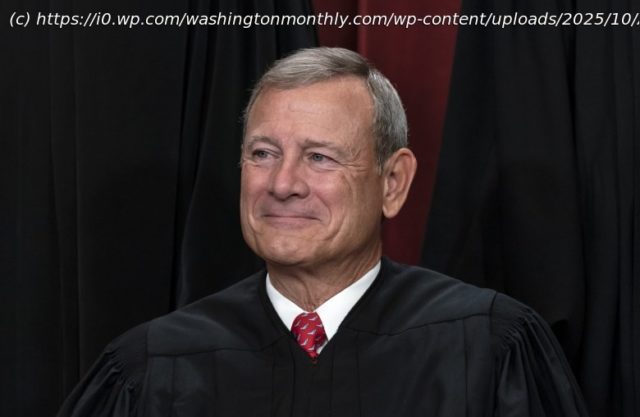For twenty years, the chief justice and his wrecking crew have toppled precedents—no wonder the Roberts Court is hemorrhaging public support.
As the Supreme Court begins its new term this first Monday in October, it’s worth noting that an important anniversary went largely unnoticed on September 29. It was the 20th anniversary of John Roberts being sworn in as chief justice of the United States and the beginning of the Roberts Court. There have been only 17 chief justices—some very memorable, like John Marshall, and others far less beneficial, like Roger Taney, author of the Dred Scott decision, which held that Black people were not citizens, making March 6, 1857, the darkest day in the Court’s history.
Roberts’s appointment came during George W. Bush’s annus horribilis—a year after the president’s 2004 reelection, when his administration mishandled Hurricane Katrina, watched its invasion of Iraq unravel, and made an ill-fated run at partially privatizing Social Security. Roberts was initially tapped to replace Justice Sandra Day O’Connor, who had announced her pending retirement on July 1, 2005. However, when Chief Justice William Rehnquist died in September 2005, Bush only waited two days to tap Roberts for the Chief’s seat and his White House Counsel, Harriet Miers, for the O’Connor vacancy. In case you’ve forgotten or are too young to remember, Miers withdrew after conservatives decried her lack of experience and worried about her right-wing bona fides. Bush got the message, dispensed with appointing another woman (or cipher) to the Court, and named a right-wing favorite, Samuel Alito of the Second Circuit, to fill the associate justice’s seat.
Twenty years into the Roberts Court, the Court’s public approval is close to its lowest since such measures began.
During Roberts’s tenure, the law has shifted significantly toward fulfilling many of the conservative legal movement’s main priorities, such as the doctrine of the “unitary executive,” which it has nearly fully embraced. This weakens the separation of powers that has served as a check and balance against a “man on horseback” for over 230 years. The largest number of Americans ever surveyed says the Court is now too conservative. Iconic liberal Justices Oliver Wendell Holmes, Louis Brandeis, Hugo Black, William O. Douglas, Earl Warren, and William Brennan must all be turning over in their graves. Justices who favored a humble, modest court that deferred to legislatures wherever possible, such as Felix Frankfurter, must also be spinning.
Now, the Roberts court may be tilting even further to the right. The doctrine of stare decisis has always been the keystone of our common law, which we inherited from England. Stare decisis means that courts must stand by what they decide. The doctrine ensures consistency and predictability in the law.
The late Justice Antonin Scalia recognized stare decisis as a guiding principle. Famously describing himself as a “faint-hearted originalist” who would abandon the historical meaning of the Constitution when following it was intolerable, he proclaimed that “stare decisis is not part of my originalist philosophy; it is a pragmatic exception to it.”
Stare decisis is sensible because, among other reasons, it protects those who have organized their affairs based on a court’s existing rulings. Why make a will or cut a business agreement unless you are confident the courts will enforce its provisions? Why marry someone of the same sex if you believe the Court’s decision that such a marriage is constitutionally guaranteed is vulnerable to being scuttled just a few years later?
Justice Clarence Thomas questions the strong foundation of stare decisis. Days before the Court’s term begins, Thomas told a Catholic University audience that he feels no duty to follow “totally stupid precedent if I find it doesn’t make any sense.” How does he determine what is “totally stupid,” the text, the original understanding, or just his gut feeling?
Thomas continued his harangue, “I think we should demand that, no matter what the case is, that it has more than just a simple theoretical basis,” Thomas said. If it’s “totally stupid, and that’s what they’ve decided, you don’t go along with it just because it’s decided.”
He added: “I don’t think that … any of these cases that have been decided are the gospel,” Thomas said during the rare public appearance. “And I do give perspective to the precedent.






